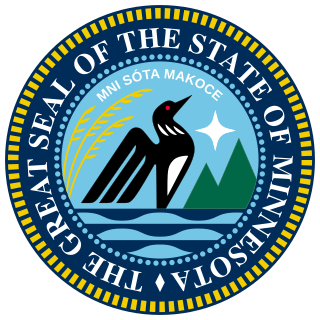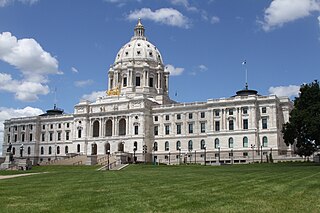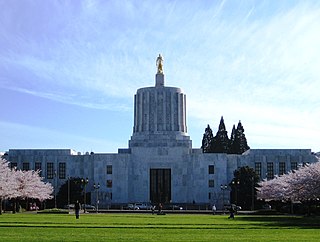
The Minnesota House of Representatives is the lower house of the U.S. state of Minnesota's legislature. It operates in conjunction with the Minnesota Senate, the state's upper house, to craft and pass legislation, which is then subject to approval by the governor of Minnesota.

The Minnesota Senate is the upper house of the Legislature of the U.S. state of Minnesota. At 67 members, half as many as the Minnesota House of Representatives, it is the largest upper house of any U.S. state legislature. Floor sessions are held in the west wing of the State Capitol in Saint Paul. Committee hearings, as well as offices for senators and staff, are located north of the State Capitol in the Minnesota Senate Building. Each member of the Minnesota Senate represents approximately 80,000 constituents.

The Hawaii State Legislature is the bicameral state legislature of the U.S. state of Hawaii, consisting of the Hawaii State Senate and the Hawaii State House of Representatives. Each lawmaker represents single member districts across the state. The powers of the legislature are granted under Article III of the Constitution of Hawaii. The legislature convenes at the Hawaii State Capitol building in the state capital of Honolulu, on the island of Oahu.

The Wisconsin State Capitol, located in Madison, Wisconsin, houses both chambers of the Wisconsin Legislature along with the Wisconsin Supreme Court and the Office of the Governor. Completed in 1917, the building is the fifth to serve as the Wisconsin capitol since the first territorial legislature convened in 1836 and the third building since Wisconsin was granted statehood in 1848. The Wisconsin State Capitol is the tallest building in Madison, a distinction that has been preserved by legislation that prohibits buildings taller than the 187 feet (57 m) columns surrounding the dome. The Capitol is located at the southwestern end of the Madison Isthmus in downtown Madison, bordered by streets that make up the Capitol Square.

The Minnesota Legislature is the bicameral legislature of the U.S. state of Minnesota consisting of two houses: the Senate and the House of Representatives. Senators are elected from 67 single-member districts. In order to account for decennial redistricting, members run for one two-year term and two four-year terms each decade. They are elected for four-year terms in years ending in 2 and 6, and for two-year terms in years ending in 0. Representatives are elected for two-year terms from 134 single-member districts formed by dividing the 67 senate districts in half.

The Minnesota State Capitol is the seat of government for the U.S. state of Minnesota, in its capital city of Saint Paul. It houses the Minnesota Senate, Minnesota House of Representatives, the office of the Attorney General and the office of the Governor. The building also includes a chamber for the Minnesota Supreme Court, although court activities usually take place in the neighboring Minnesota Judicial Center.

The Wyoming State Capitol is located in the city of Cheyenne. Cheyenne is the seat of government for the U.S. state of Wyoming, also hosting the workspace for the governor, and his staff; Mark Gordon. Built between 1886 and 1890, the capitol is located in Cheyenne and contains the chambers of the Wyoming State Legislature as well as the office of the Governor of Wyoming. It was designated a U.S. National Historic Landmark in 1987. The Capitol underwent an extensive three-year renovation and reopened to the public on July 10, 2019.

The Iowa State Capitol, commonly called the Iowa Statehouse, is in Iowa's capital city, Des Moines. As the seat of the Iowa General Assembly, the building houses the Iowa Senate, Iowa House of Representatives, the Office of the Governor, and the Offices of the Attorney General, Auditor, Treasurer, and Secretary of State. The building also includes a chamber for the Iowa Supreme Court, although court activities usually take place in the neighboring Iowa Supreme Court building. The building was constructed between 1871 and 1886, and is the only five-domed capitol in the country.

The Oklahoma State Capitol is the house of government of the U.S. state of Oklahoma. It is the building that houses the Oklahoma Legislature and executive branch offices. It is located along Lincoln Boulevard in Oklahoma City and contains 452,508 square feet of floor area. The present structure includes a dome completed in 2002.

The New Mexico State Capitol is the seat of government of the U.S. state of New Mexico, located in its capital city of Santa Fe. It houses both chambers of the New Mexico Legislature and the offices of the Governor, Lieutenant Governor, and Secretary of State. The building is one of only eleven state capitols without a dome, and the only circular state capitol in the United States, for which it is commonly known as "the Roundhouse".

The Arizona Territorial - Arizona State Capitol in Phoenix, Arizona, United States, was the last home for Arizona's territorial government until Arizona became a state in 1912. Initially, all three branches of the new state government occupied the four floors of the statehouse. As the state expanded the branches relocated to adjacent buildings and additions. The 1901 portion of the capitol is now maintained as the Arizona Capitol Museum with a focus on the history and culture of Arizona. The Arizona State Library, which occupied most of the 1938 addition until July 2017, re-opened in late 2018 as a part of the Arizona Capitol Museum.

The Maine State House in Augusta, Maine, is the state capitol of the State of Maine. The building was completed in 1832, one year after Augusta became the capital of Maine. Built using Maine granite, the State House was based on the design of the Massachusetts State House.

The North Dakota State Capitol is the house of government of the U.S. state of North Dakota. The capitol, a 21-story Art Deco tower, is located in Bismarck at 600 East Boulevard Avenue, and is the tallest habitable building in the state. On a 160-acre (0.6 km2) campus that also houses many other government buildings, the capitol building and the surrounding office buildings house the state's legislative and judicial branches, as well as many government agencies.

The Oregon State Capitol is the building housing the state legislature and the offices of the governor, secretary of state, and treasurer of the U.S. state of Oregon. It is located in the state capital, Salem. Constructed from 1936 to 1938 and expanded in 1977, the current building is the third to house the Oregon state government in Salem. The first two capitols in Salem were destroyed by fire, one in 1855 and the other in 1935.

The Michigan State Capitol is the building that houses the legislative branch of the government of the U.S. state of Michigan. It is in the portion of the state capital of Lansing which lies in Ingham County.

First Capitol Historic Site is a free-admission historic museum located outside Belmont, Wisconsin, United States. The museum includes two of the buildings first used by legislators to meet in Wisconsin Territory. Currently owned and operated by the Wisconsin Historical Society, the site is listed on the National Register of Historic Places.

LeRoy Sunderland Buffington (1847–1931) was an American architect from Minnesota who specialized in hotels, public and commercial buildings, churches, and residences. He was born September 22, 1847, in Cincinnati, Ohio. He studied architecture and engineering at the University of Cincinnati and graduated in 1869. He later moved to Saint Paul, becoming a partner of Abraham Radcliffe, and worked on the remodeling of the original Minnesota State Capitol. After the first capitol burned down, Buffington designed a replacement that served as the State House until 1904. In 1881 he claimed to have invented the method of building skyscrapers using load-bearing iron frames. He applied for a patent in November 1887 and received it in May 1888. Even though many subsequent builders used this method of construction, Buffington was mostly unsuccessful in collecting royalties from his patent. Buffington remained in private practice in Minneapolis until his death on February 15, 1931.

James A. Nash is an American politician serving in the Minnesota House of Representatives since 2015. A member of the Republican Party of Minnesota, Nash represents District 48A in the western Twin Cities metropolitan area, which includes the cities of Waconia, Victoria, and Chaska, and parts of Carver County.

After fire destroyed the U.S. state of Minnesota's first capitol building on March 1, 1881, the second capitol, completed in 1883, served as the seat of Minnesota state government for just 10 years before state officials began planning a grander, more efficient Capitol. The second Capitol building stood on the site of the first Capitol for 55 years until its demolition in 1937.

The current Minnesota State Capitol in Saint Paul was constructed from 1896 to 1905; shortly after the previous Capitol opened, it proved to be unsuitable due to overcrowding, a lack of adequate fireproofing, and poor ventilation. State officials began planning a grander, more-efficient Capitol. In 1893, Governor Knute Nelson appointed the seven-member Board of State Capitol Commissioners to oversee the construction of a new Capitol following the state legislature's recommendation. The commissioners selected local architect Cass Gilbert's design and chose a site at Wabasha Hill that was bounded by Park Avenue, University Avenue, Cedar and Wabasha Streets, and Central Avenue. Although it was the most expensive option, the chosen site was the largest of the four shortlisted sites, and the commission concluded it was the best location for the building.



















